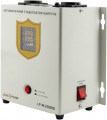The maximum active load power allowed for this model.
Active power is the power that in AC appliances is spent on useful work or on heat generation. In addition to it, such devices also consume reactive power — it goes to the operation of specific components, primarily capacitors and inductors. Apparent power, denoted in volt-amperes (kilovolt-amperes), is the sum of active and reactive, see below about it. Here we note that in simple everyday situations, there is enough data on active power indicated in watts for calculations. In particular, it is this parameter that is considered the key when choosing stabilizers
for washing machines and
dishwashers : in the first case, power from 2 to 5 kW is considered optimal, in the second — from 1.8 to 2.5 kW.
Anyway, the total active power of the connected load should not exceed the figures indicated in the characteristics of the stabilizer. For a full guarantee, it's ok to take a certain margin, but this margin should not be too large — an increase in the allowable power significantly affects the dimensions, weight and price of the device. Also note that there are formulas that allow you to convert the active power consumption into total power, taking into account the type of connected electrical appliance; these formulas can be found in special sources.
The number of
sockets for 230 V with grounding provided in the design of the stabilizer.
Some electrical appliances, such as refrigerators and washing/dishwashers, must be grounded when connected. This point should not be ignored — there is a risk of a serious electric shock. Accordingly, the number of sockets with grounding corresponds to the maximum number of such devices that can be simultaneously connected to the stabilizer without the use of splitters. At the same time, ungrounded devices can also be connected to such sockets.
The presence in the design of the stabilizer of at least two pairs of terminals — at the input and at the output. Unlike sockets, which are designed for frequent connections and disconnections, the
terminal connection is designed to permanently secure the wires — roughly speaking, "attached — clamped — forgot." It does not involve direct connection of electrical appliances, usually the power from the terminals goes further into the mains and is already distributed through it to individual sockets in the room. Accordingly, this option is typical for powerful models (on average from 3 kVA and above, see "Power"), which are designed for installation in one place as a permanent element of the power grid. Often such stabilizers do not have their own outlets at all — only terminals.

